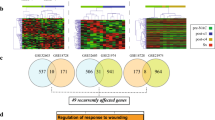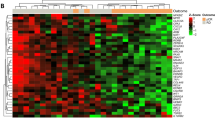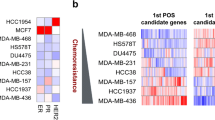Abstract
Neoadjuvant chemotherapy has been shown to be equivalent to post-operative treatment for breast cancer, and allows for assessment of chemotherapy response. In a pilot trial of docetaxel (T) and capecitabine (X) neoadjuvant chemotherapy for Stage II/III BC, we assessed correlation between baseline gene expression and tumor response to treatment, and examined changes in gene expression associated with treatment. Patients received four cycles of TX. Tumor tissue obtained from Mammotome™ core biopsies pretreatment (BL) and post-cycle 1 (C1) of TX was flash frozen and stored at −70°C until processing. Gene expression analysis utilized Affymetrix HG-U133 Plus 2.0 GeneChip arrays. Statistical analysis was performed using BRB Array Tools after RMA normalization. Gene ontology (GO) pathway analysis used random variance t tests with a significance level of P < 0.005. For gene categories identified by GO pathway analysis as significant, expression levels of individual genes within those pathways were compared between classes using univariate t tests; those genes with significance level of P < 0.05 were reported. PAM50 analyses were performed on tumor samples to investigate biologic subtype and risk of relapse (ROR). Using GO pathway analysis, 39 gene categories discriminated between responders and non-responders, most notably genes involved in microtubule assembly and regulation. When comparing pre- and post-chemotherapy specimens, we identified 71 differentially expressed gene categories, including DNA repair and cell proliferation regulation. There were 45 GO pathways in which the change in expression after one cycle of chemotherapy was significantly different among responders and non-responders. The majority of tumor samples fell into the basal-like and luminal B categories. ROR scores decreased in response to chemotherapy; this change was more evident in samples from patients classified as responders by clinical criteria. GO pathway analysis identified a number of gene categories pertinent to therapeutic response, and may be an informative method for identifying genes important in response to chemotherapy. Larger studies using the methods described here are necessary to fully evaluate gene expression changes in response to chemotherapy.




Similar content being viewed by others
References
Berry DA, Cronin KA, Plevritis SK, Fryback DG, Clarke L, Zelen M et al (2005) Effect of screening and adjuvant therapy on mortality from breast cancer. N Engl J Med 353(17):1784–1792
Harlan LC, Clegg LX, Abrams J, Stevens JL, Ballard-Barbash R (2006) Community-based use of chemotherapy and hormonal therapy for early-stage breast cancer: 1987–2000. J Clin Oncol 24(6):872–877
Andre F, Mazouni C, Hortobagyi GN, Pusztai L (2006) DNA arrays as predictors of efficacy of adjuvant/neoadjuvant chemotherapy in breast cancer patients: current data and issues on study design. Biochim Biophys Acta 1766(2):197–204
Chuthapisith S, Eremin JM, Eremin O (2008) Predicting response to neoadjuvant chemotherapy in breast cancer: molecular imaging, systemic biomarkers and the cancer metabolome (review). Oncol Rep 20(4):699–703
Lebowitz PF, Eng-Wong J, Swain SM, Berman A, Merino MJ, Chow CK et al (2004) A phase II trial of neoadjuvant docetaxel and capecitabine for locally advanced breast cancer. Clin Cancer Res 10(20):6764–6769
Simon R, Lam A, Li MC, Ngan M, Menenzes S, Zhao Y (2007) Analysis of gene expression data using BRB-array tools. Cancer Inform 2:11–17
Chang JC, Wooten EC, Tsimelzon A, Hilsenbeck SG, Gutierrez MC, Elledge R et al (2003) Gene expression profiling for the prediction of therapeutic response to docetaxel in patients with breast cancer. Lancet 362(9381):362–369
Parker JS, Mullins M, Cheang MC, Leung S, Voduc D, Vickery T et al (2009) Supervised risk predictor of breast cancer based on intrinsic subtypes. J Clin Oncol 27(8):1160–1167
Eisenhauer EA, Vermorken JB (1998) The taxoids. Comparative clinical pharmacology and therapeutic potential. Drugs 55(1):5–30
Goncalves A, Braguer D, Kamath K, Martello L, Briand C, Horwitz S et al (2001) Resistance to taxol in lung cancer cells associated with increased microtubule dynamics. Proc Natl Acad Sci USA 98(20):11737–11742
McGrogan BT, Gilmartin B, Carney DN, McCann A (2008) Taxanes, microtubules and chemoresistant breast cancer. Biochim Biophys Acta 1785(2):96–132
Welcsh PL, King MC (2001) BRCA1 and BRCA2 and the genetics of breast and ovarian cancer. Hum Mol Genet 10(7):705–713
Farmer H, McCabe N, Lord CJ, Tutt AN, Johnson DA, Richardson TB et al (2005) Targeting the DNA repair defect in BRCA mutant cells as a therapeutic strategy. Nature 434(7035):917–921
Martin SA, Lord CJ, Ashworth A (2008) DNA repair deficiency as a therapeutic target in cancer. Curr Opin Genet Dev 18(1):80–86
Wolff AC, Berry D, Carey LA, Colleoni M, Dowsett M, Ellis M et al (2008) Research issues affecting preoperative systemic therapy for operable breast cancer. J Clin Oncol 26(5):806–813
Easton DF, Pooley KA, Dunning AM, Pharoah PD, Thompson D, Ballinger DG et al (2007) Genome-wide association study identifies novel breast cancer susceptibility loci. Nature 447(7148):1087–1093
Hunter DJ, Kraft P, Jacobs KB, Cox DG, Yeager M, Hankinson SE et al (2007) A genome-wide association study identifies alleles in FGFR2 associated with risk of sporadic postmenopausal breast cancer. Nat Genet 39(7):870–874
Gan Y, Wientjes MG, Au JL (2006) Expression of basic fibroblast growth factor correlates with resistance to paclitaxel in human patient tumors. Pharm Res 23(6):1324–1331
Song S, Wientjes MG, Gan Y, Au JL (2000) Fibroblast growth factors: an epigenetic mechanism of broad spectrum resistance to anticancer drugs. Proc Natl Acad Sci USA 97(15):8658–8663
Mano Y, Takahashi K, Ishikawa N, Takano A, Yasui W, Inai K et al (2007) Fibroblast growth factor receptor 1 oncogene partner as a novel prognostic biomarker and therapeutic target for lung cancer. Cancer Sci 98(12):1902–1913
Vallbohmer D, Yang DY, Kuramochi H, Shimizu D, Danenberg KD, Lindebjerg J et al (2007) DPD is a molecular determinant of capecitabine efficacy in colorectal cancer. Int J Oncol 31(2):413–418
Pusztai L, Anderson K, Hess KR (2007) Pharmacogenomic predictor discovery in phase II clinical trials for breast cancer. Clin Cancer Res 13(20):6080–6086
Lusa L, McShane LM, Reid JF, De Cecco L, Ambrogi F, Biganzoli E et al (2007) Challenges in projecting clustering results across gene expression-profiling datasets. J Natl Cancer Inst 99(22):1715–1723
Acknowledgments
This research was supported by the Intramural Research Program of the NIH and National Cancer Institute. We would like to thank Drs. Matthew Ellis and Charles E. Perou for their assistance with analysis and interpretation of PAM50. We would also like to thank the patients involved in this study for their participation.
Author information
Authors and Affiliations
Corresponding author
Electronic supplementary material
Below is the link to the electronic supplementary material.
Rights and permissions
About this article
Cite this article
Korde, L.A., Lusa, L., McShane, L. et al. Gene expression pathway analysis to predict response to neoadjuvant docetaxel and capecitabine for breast cancer. Breast Cancer Res Treat 119, 685–699 (2010). https://doi.org/10.1007/s10549-009-0651-3
Received:
Accepted:
Published:
Issue Date:
DOI: https://doi.org/10.1007/s10549-009-0651-3




